Mexican Catholic tradition recalls the journey of Mary and Joseph before Christ’s birth
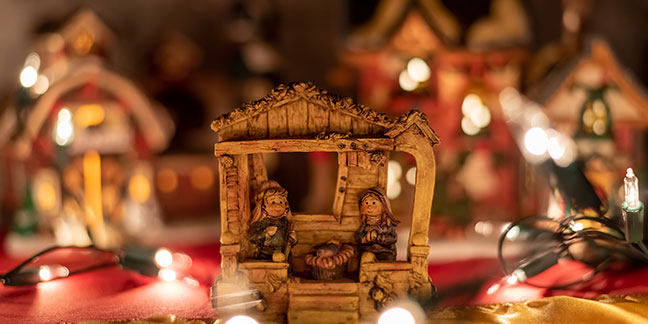
Celebrate the holy seasons of Advent and Christmas with a beautiful Mexican tradition known as “Las Posadas” or “The Inns.”
Part Christmas pageant and part Christmas novena, it is a faith-filled, entertaining way to gather with loved ones, recall the journey of Joseph and Mary to Bethlehem, and prepare your heart for the birth of Our Savior.
At its heart, Las Posadas is a nine-day novena that starts Thursday, Dec. 16, and runs through Dec. 24. It typically involves family, friends and communities coming together each evening to remember the Holy Family’s journey from Nazareth and their search to find a room in Bethlehem.
Participants begin with prayer and re-enact the Holy Family’s journey, sometimes with children dressed as Joseph and Mary arriving at the door of the host’s home. Singing carols and sharing refreshments are also important components of each evening’s gatherings.
History of Las Posadas
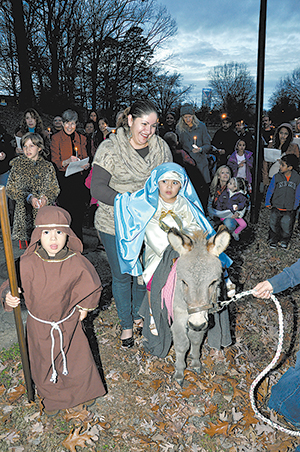 Children dressed as Mary and Joseph take part in a local Las Posadas celebration. (File, Catholic News Herald)The celebration has been a Mexican tradition for more than 400 years. It began as a way for Spanish missionaries – specifically, the Augustinian friars of San Agustin de Acolman, near Mexico City – to teach the story of Christ’s birth by reinventing some native pagan practices. In 1586, Friar Diego de Soria, the Augustinian prior, obtained a papal bull from Pope Sixtus V to celebrate what was called “Misas de Aguinaldo” or “Christmas bonus Masses” between Dec. 16 and 24.
Children dressed as Mary and Joseph take part in a local Las Posadas celebration. (File, Catholic News Herald)The celebration has been a Mexican tradition for more than 400 years. It began as a way for Spanish missionaries – specifically, the Augustinian friars of San Agustin de Acolman, near Mexico City – to teach the story of Christ’s birth by reinventing some native pagan practices. In 1586, Friar Diego de Soria, the Augustinian prior, obtained a papal bull from Pope Sixtus V to celebrate what was called “Misas de Aguinaldo” or “Christmas bonus Masses” between Dec. 16 and 24.
By the 18th century, Las Posadas gained popularity and were enriched by joyful songs and other elements such as piñatas, fireworks and dancing.
Las Posadas were typical of the so-called New Spain, but they soon spread to other regions of the Americas. And there are now similar traditions elsewhere in the Church – for example, Filipinos celebrate Simbang Gabi, Puerto Ricans celebrate Misa de Aguinaldo, Cubans have Parrandas, and Colombians pray the Novena de Aguinaldos.
The way of celebrating Las Posadas has changed over time, and customs from different cultures and generations have been added. But the occasion has always been characterized by prayer, songs, food and hospitality. This year, why not incorporate this delightful tradition into your Advent preparations to receive the “Niño Dios” at Christmas?
— SueAnn Howell and César Hurtado, Catholic News Herald
How to do it
Each Las Posadas celebration has three components: prayer and the caminata, food and a piñata:
Prayer and Caminata
Las Posadas begins with prayer – such as reciting the rosary – and then continues with a “caminata” or procession, a re-enactment of Joseph and Mary’s search for a room.
What you need:
- Three homes designated as “inns,” or three doors that open to the outside
- Two people dressed as Mary and Joseph (usually children), or a picture of the Holy Family
- Musical instruments such as a guitar, tambourines or maracas
- Printed lyrics of the Las Posadas Song, “Pedir Posada,” and other Christmas carols
- A rosary and one person to lead everyone in prayer
- Candles and sparklers
- Refreshments (details follow)
- Piñata, blindfold and stick
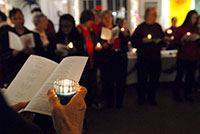 First, everyone gathers to pray the rosary, usually around a Nativity scene or set. Some Las Posadas celebrations include singing a Christmas carol after each decade of the rosary.
First, everyone gathers to pray the rosary, usually around a Nativity scene or set. Some Las Posadas celebrations include singing a Christmas carol after each decade of the rosary.
Then participants divide into two groups for the procession or “caminata” which will go from house to house or door to door.
One group stays inside each house or behind each door, while the other group takes part in the procession outside.
The head of the procession carries a candle. Pilgrims can carry images of the Holy Family or two people may play the parts of Mary (María) and Joseph (José), with others dressed as angels and shepherds. Give each person a candle and, if age appropriate, a few sparklers. The candles are lit during the procession, and the sparklers are lit at the end, just before dinner.
The procession is accompanied by musicians, with everyone singing carols such as the Las Posadas Song, “Pedir Posada.”
At each of the first two houses or doors, the pilgrims (“Peregrinos”) approach and sing the Las Posadas Song. The inside groups respond with their section of the verses, but do not open the door. Then, the outside group moves to the third door singing, and the inside group finally opens the door.
At the end of the caminata, everyone sings Christmas carols, children break open star-shaped piñatas and everyone gathers for a feast.
- Las Posadas Song, in English and Spanish, with music to accompany
- Print Las Posasas Song lyrics here and here
Refreshments
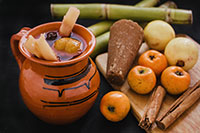 There are three traditional food elements for Las Posadas: fruit, candy and dinner.
There are three traditional food elements for Las Posadas: fruit, candy and dinner.
Usually, bags of fruit are passed around while guests wait for dinner. Traditional bags include one orange, one mandarin, a piece of sugar cane (candy canes make a good substitute), two or three tejocotes (Mexican hawthorne), one guava and a good helping of roasted peanuts in shells.
Dinner usually consists of traditional Mexican antojitos (“little cravings”), usually street snacks or appetizers such as tacos, tamales, enchiladas, pozole, etc.
Here are a few links with yummy recipes courtesy of www.MamaLatinaTips.com:
- Green pozole with chicken
- Red pozole with pork
- Pineapple guava tamales
- Chile verde tamales
- Easy chipotle enchiladas
- Chicken enchiladas in green sauce
- Barbacoa tacos
- Miner’s tacos
- Shredded chipotle beef tacos
- Avocado chicken enchiladas
- Chicken and linguica tacos dorados
- Tacos al Pastor
Beverages:
The traditional beverage to serve is Mexican ponche – a hot, spiced beverage made with fruit, water and sugar. Other options are Mexican hot chocolate, lime or pumpkin atole, and chapurrado, especially if you serve tamales.
After dinner, the host comes out with a basket of aguinaldos – small bags with sweets, including candy and cookies – to give each guest.
Piñata
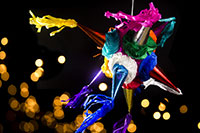 The piñata actually originated with Las Posadas. The first piñata shape was a seven-pointed shining star, representing the star that led the Wise Men to adore the Christ Child. The seven points represent the seven deadly sins. Being blindfolded represents faith, and the stick represents virtue. Beating the piñata represents the overcoming of sin, and the treats inside represent the glory of God falling down upon us.
The piñata actually originated with Las Posadas. The first piñata shape was a seven-pointed shining star, representing the star that led the Wise Men to adore the Christ Child. The seven points represent the seven deadly sins. Being blindfolded represents faith, and the stick represents virtue. Beating the piñata represents the overcoming of sin, and the treats inside represent the glory of God falling down upon us.
Sing the irresistible earworm “Dale, dale, dale” (“Hit, Hit, Hit It”) as each person takes their crack at the piñata. This song has two practical purposes. First, it enables everyone to have fun and participate, even when you are not hitting the piñata yourself.
Plus, the song’s length sets the perfect time limit for each person’s turn before passing the stick on to the next in line.
Some Las Posadas gatherings feature two piñatas – one for smaller children and one for the older children, one for girls and one for boys, or simply two to make sure everybody gets a hit in before the piñatas are split open.
After the caminata, dinner and piñatas, participants gather around to talk, eat more candy and mingle until late in the evening. Then everybody goes home and gets ready for the next Las Posadas celebration at another’s house the following day!
You can do all nine days of Las Posadas celebrations, you can do just a few, or you can host one big potluck. Either way, have fun customizing this beloved Mexican tradition for your family this holy season.
- Make your own star piñata
- Pinata Song “Dale, Dale, Dale” featuring lyrics in Spanish and English
— www.mamalatinatips.com, Wikipedia


